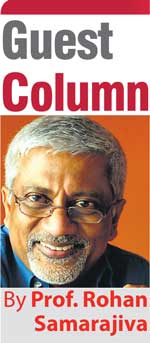Sunday Apr 20, 2025
Sunday Apr 20, 2025
Friday, 8 November 2024 00:20 - - {{hitsCtrl.values.hits}}

Unless those responsible for Government digitalisation develop an alternative to the present broken procurement model, the great hopes that have been placed on digitalisation are unlikely to be realised
 If there is anything everyone supports, it’s digitalisation of government. It’s seen as the panacea for all our ills: tax avoidance, corruption, inefficient agriculture… You name a problem, that is the answer, or at least part of the answer. We’ve been trying for over two decades but with meagre returns.
If there is anything everyone supports, it’s digitalisation of government. It’s seen as the panacea for all our ills: tax avoidance, corruption, inefficient agriculture… You name a problem, that is the answer, or at least part of the answer. We’ve been trying for over two decades but with meagre returns.
What lessons for a reset can be drawn from our successes and failures? This moment when Dr. Hans Wijayasuriya has agreed to serve as Chief Advisor on the Digital Economy is an opportunity for a reset.
Success outside the lines
Go back to mid 2022. Think of the queues. In some places, three parallel lines as far as the eye could see, with only one lane left for traffic. The first challenge was to get fuel. The second was to navigate roads blocked by fuel queues.
By end July, the queues were gone thanks to a digital solution, commonly described as the QR app, deployed under the leadership of Minister Kanchana Wijesekera. Not only did the queues disappear; the country’s mood changed from doom and gloom to one of calm.
Clearly, a success story. But one that was achieved outside the procedures used for deploying IT systems in government. It can tell us what is wrong with the standard procedures.
As the fuel shortages started to bite there was some talk of vehicles being registered at specific fuel stations and being issued a fuel quota. This was thinking from the 1970s Sirimavo era. It disregarded the massive increase in vehicles since then and the need for vehicles to refuel from multiple locations. A system based on last digits of number plates was tried but failed to make a dent in the queues. The solution was a digital rationing system.
Under standard procedure, someone, possibly at the ICT Agency, should have worked with the line ministry to develop a scope of work and estimated what it would cost. A tender board and a technical evaluation committee should have been appointed and the work bid out in a manner that satisfied the various procedural requirements.
The bids that met the technical requirements should have been ranked according to a pre-set marking scheme. Then the scores for technical competence and the financial bids should have been combined and a decision announced by the tender board. In the best case, procurement would have been completed by end 2022.
The different elements of the work (the cleaning of the data from the Department of Motor Traffic, designing the app, training the fuel station employees, etc.) would have commenced in 2023. It is unlikely that they would have been done in parallel, given it was a Government project. One dreads to think how long the process would have taken.
Leaving aside the time factor, the procedure would not have yielded a working system. Expecting the scope of work to perfectly describe the desired result is obviously unrealistic for a complex interconnected system, and perhaps even for simpler IT systems. In the case of the fuel rationing system, the designers had to adapt as they went along. For example, it was found that not all vehicles could be registered using the chassis number. Revenue licenses had to be accommodated, in addition. Because the system was not developed based on a rigid scope of work, changes could be made as problems were identified. Agile versus waterfall in the language of the industry.
A complex system that requires instantaneous responses to queries by relatively unsophisticated pump attendants in over 1,000 fuel stations across the country is a tough task. Getting to full deployment within 6-8 weeks was possible because two companies (Dialog Axiata and LSEG, formerly Millennium IT) donated the time of their best engineers allowing the standard procurement procedure to be bypassed. ICTA and partners trained the fuel station workers while the software was being developed and managed the project. A young and dynamic minister, Kanchana Wijesekera, made quick decisions and kept the project moving.
What happens within the lines
 Most Government departments lack the capacity to procure IT systems. The solution has been to seek the assistance of ICTA, which was established specifically for this purpose. Contrary to perception, ICTA does not have a cadre of software developers, architects, etc. who can be deployed on projects. The model that was adopted from the outset was one in which private firms would be competitively selected.
Most Government departments lack the capacity to procure IT systems. The solution has been to seek the assistance of ICTA, which was established specifically for this purpose. Contrary to perception, ICTA does not have a cadre of software developers, architects, etc. who can be deployed on projects. The model that was adopted from the outset was one in which private firms would be competitively selected.
The revenue license system is one of the largest systems in operation. Citizens do not obtain a driving license or a passport every year. But every vehicle owner must interact with the relevant Provincial Council each year to obtain a revenue license. With over six million vehicles (mostly two and three-wheelers) on the road, the annual revenue license renewal is among the most important of State services.
It is also one of the most complex, requiring real-time verification of documents issued by other agencies such as emission test certificates and insurance. Almost all vehicles have been licensed annually using a computerised system for some time. That means 25,000 to 30,000 transactions per working day.
A revenue license may be renewed by going to a Divisional Secretariat Office and dealing with an official at a counter; or by using a kiosk in a government office (introduced in the Northern Province); or online from any location. All three interfaces connect to the same backend. Use of the online option is quite low and seen by officials as something bad.
According to government survey data supplemented by LIRNEasia research on the effects of COVID lockdowns, 2.1 million persons out of a population of 22 million had used government websites in 2019. This was an increase over the 1.5 million in 2018, but still considerably fewer than the number of persons who need to renew their revenue licenses every year. Government data shows that the number of households with desktop or laptop computers has been declining since 2017, when it was 22.8%. In 2019, it was 22%.
What above data shows is that the license renewal process should have been redesigned to be mobile-first, like the fuel-rationing app. Shortcomings such as the need to print a temporary license (difficult to do from a phone) would be addressed. Multiple payment options, again optimised for smartphones, would be provided. But given the many citizens who still do not or cannot access Government services online, the online mode must be supplemented with kiosks and mediated modes.
By 2018, it was understood that the system needed a thorough overhaul and a redesign. But the procurement process moved at a snail’s pace because of obstructionist officials on the tender board. It was not completed by the time the Government changed in 2019. As predicted, the backend crashed a few years later.
There are many flaws in the extant model, other than those described above. The senior officials who sign off on the scope of work usually retire or are transferred before the work is done. As a result, multiple and sometimes contradictory requests for deviations come from the client. In most cases, the “owner” of the IT system fails to develop internal capacity either becoming subject to over-reliance on the vendor (vendor capture), or the system is abandoned after a time.
An alternative model
Flaws like those described above are not unique to Sri Lanka. Replacing the legacy health records system of the US Veterans Administration has become a multi-billion-dollar disaster. The website that was critical for the success of Obamacare crashed on the first day, and had to be reconstructed by importing top engineers from Silicon Valley.
In the former case, the cause was sticking with the traditional procurement procedure, similar to what was used in Sri Lanka’s revenue license system. The Obamacare rescue was done by using a different model, similar to what was used in Sri Lanka’s fuel rationing app. But critical to that approach was project coordination by tech-savvy and self-confident ICTA personnel and the leadership and trouble-shooting provided by Minister Wijesekera.
The lessons of the fuel rationing system success and the US experience must be used to develop an alternative to the current failed model. This will require something on the lines of the US Digital Service that emerged from the Obamacare experience. Here, industry professionals serve in government for limited tours of duty that see them paired with senior officials who have deep knowledge of the systems that require fixing. Because maintenance is as important as good design, building up capacity within each Government organisation is critical. Lack of knowledge and reluctance to admit that lack has been the cause of many failures in Government IT system deployments.
Unless those responsible for Government digitalisation develop an alternative to the present broken procurement model, the great hopes that have been placed on digitalisation are unlikely to be realised.
Discover Kapruka, the leading online shopping platform in Sri Lanka, where you can conveniently send Gifts and Flowers to your loved ones for any event including Valentine ’s Day. Explore a wide range of popular Shopping Categories on Kapruka, including Toys, Groceries, Electronics, Birthday Cakes, Fruits, Chocolates, Flower Bouquets, Clothing, Watches, Lingerie, Gift Sets and Jewellery. Also if you’re interested in selling with Kapruka, Partner Central by Kapruka is the best solution to start with. Moreover, through Kapruka Global Shop, you can also enjoy the convenience of purchasing products from renowned platforms like Amazon and eBay and have them delivered to Sri Lanka.
Discover Kapruka, the leading online shopping platform in Sri Lanka, where you can conveniently send Gifts and Flowers to your loved ones for any event including Valentine ’s Day. Explore a wide range of popular Shopping Categories on Kapruka, including Toys, Groceries, Electronics, Birthday Cakes, Fruits, Chocolates, Flower Bouquets, Clothing, Watches, Lingerie, Gift Sets and Jewellery. Also if you’re interested in selling with Kapruka, Partner Central by Kapruka is the best solution to start with. Moreover, through Kapruka Global Shop, you can also enjoy the convenience of purchasing products from renowned platforms like Amazon and eBay and have them delivered to Sri Lanka.